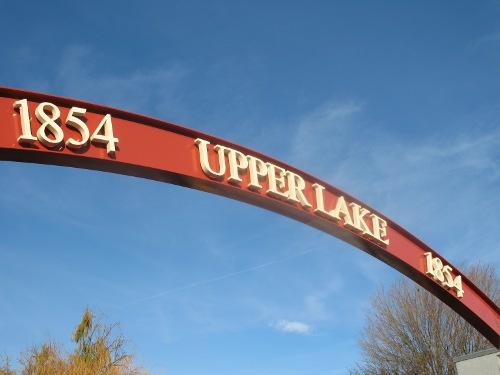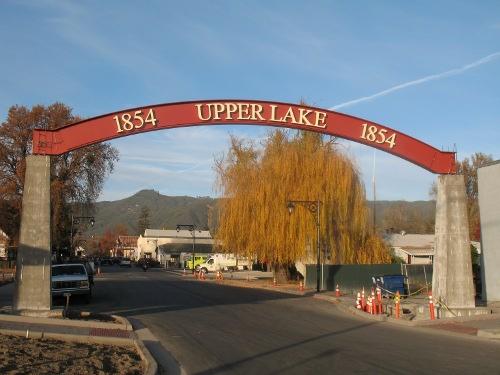
Cotati resident Harold Chouinard's Schleicher ASW 27 glider, foreground, and a Piper PA 25 tow plane flown by Robert Boylan of Hidden Valley Lake, landed to the east of the runway at Crazy Creek Air Adventures in Middletown after they collided mid-air on the morning of Saturday, November 28, 2009. The aircraft are pictured on Monday, November 30, 2009, a short time before they were removed from the scene. Photo by Elizabeth Larson.
THIS STORY HAS BEEN UPDATED.
MIDDLETOWN – On the morning that a preliminary investigation into a Saturday mid-air collision near Middletown was wrapping up, local officials released the names of the two men who died in the crash.
Capt. James Bauman of the Lake County Sheriff's Office reported Monday that 44-year-old Robert Sean Boylan of Hidden Valley Lake and 63-year-old Harold Harvey Chouinard of Cotati were the crash victims.
Boylan was piloting a Piper PA 25 tow plane and Chouinard was in a Schleicher ASW 27 glider when they collided, according to Eliott Simpson, an aviation accident investigator with the National Transportation Safety Board, who remained on the scene Monday morning.
Simpson said that, based on witness reports, both men were approaching the landing strip at Crazy Creek Air Adventures from different directions when the crash occurred.
He said the glider was coming on the right downward leg and the tow plane was the left downward leg, with both circling to land. They hit at the approach end of the runway.
The equipment on both the glider and plane had appeared to be in working order based on Simpson's preliminary onscene investigation.
Bauman reported that sheriff's deputy coroners responded to the scene at about 11:40 a.m. Saturday. Rescue personnel from Cal Fire were already on scene when deputies arrived and both the Federal Aviation Administration and the NTSB had been notified of the collision.
When deputies arrived at the scene, Bauman said they were led to the wreckage, where they found the pilots of both aircraft near their respective crafts. Boylan and Chouinard both were pronounced dead at the scene.
Bauman said that, due to extended response times by the FAA and the NTSB, deputies secured and guarded the crash scene throughout the day and night until both federal agencies could arrive to investigate the cause of the collision the following day.
Autopsies will be scheduled to determine the exact cause of death for both of the pilots, Bauman said.
The two aircraft came to rest in a pasture several hundred yards to the east of the approach end of the landing strip. The plane was sitting about 100 yards to the north of the glider, facing in a northerly direction, while the glider was pointed toward the runway.

The wreckage of the tow plane, sitting where it landed in a pasture near the landing strip at Crazy Creek Air Adventures in Middletown. The plane was moved a few hours after the picture was taken on Monday, November 30, 2009. Photo by Elizabeth Larson.
On Monday the wreckage remained where it had landed, said Simpson, except that he had the glider turned over so that it was sitting right side up for the purposes of the investigation.
Following the collision the glider had landed on its top and fire personnel cut off the right side wing as they worked to rescue Chouinard, Simpson said.
Both aircraft were surrounded by small debris fields. The wheel of the plane lay about 30 feet from it.
The glider's tail section bore the name “Hal,” for Chouinard, under whose name it was licensed, according to FAA records. The registration certificate was issued in April of 2003.
The tow plane was licensed to Cal Soar Inc., at the same address as Crazy Creek Air Adventures on Grange Road. That certificate was issued in July of 1992, FAA records showed.
Six people, who Simpson said were family members of Boylan, visited the crumpled wreckage of the tow plane early Monday morning. They walked slowly around it and then stood quietly together. As they left the field they declined the request for a comment.
Simpson, who has been doing the investigations for about three years, is an engineer who also is a pilot. Most of the NTSB investigators have a piloting background, he said.
“We have to investigate every single civil aircraft crash,” said Simpson, who is based in Los Angeles. About 15 NTSB investigators are based on the West Coast, he added.
The cause of the crash itself is yet to be determined. Simpson said a preliminary reported will be available within the next five to 10 days, with a final factual report likely to be completed in about six months, although it could take as long as nine months to finish.
That report will then go to Washington, DC, to the full safety board, which will determine the collision's probable cause, Simpson said.
Simpson expected to be at the Middletown crash site until noon on Monday, noting that the onscene portion of the investigation was complete.
“So now it's just recovery,” he said.
The aircraft were recovered later Monday morning and transported to a privately owned storage facility in Sacramento, Simpson said.
The facility, which was hired by the insurance companies covering the aircraft, will store the plane and glider during the investigation, Simpson said.
“They're there in case anything else comes to light,” he said.
E-mail Elizabeth Larson at This email address is being protected from spambots. You need JavaScript enabled to view it. . Follow Lake County News on Twitter at http://twitter.com/LakeCoNews and on Facebook at http://www.facebook.com/pages/Lake-County-News/143156775604?ref=mf .

 How to resolve AdBlock issue?
How to resolve AdBlock issue? 














